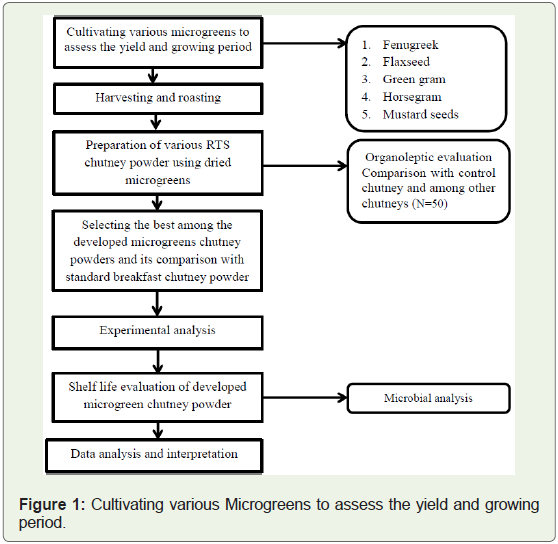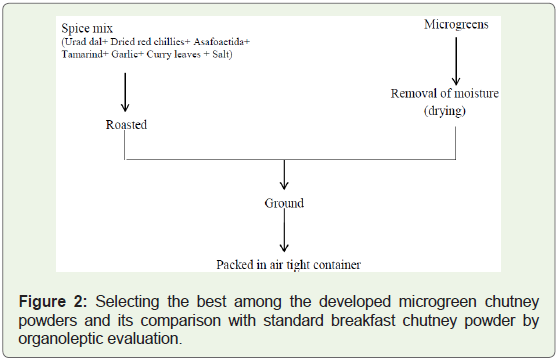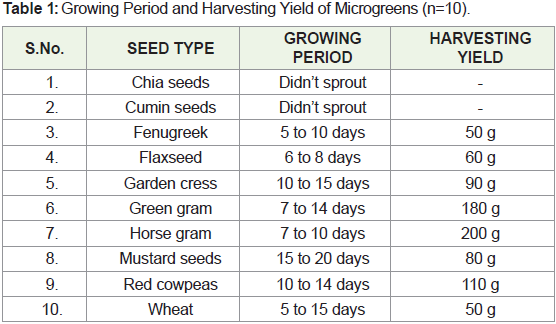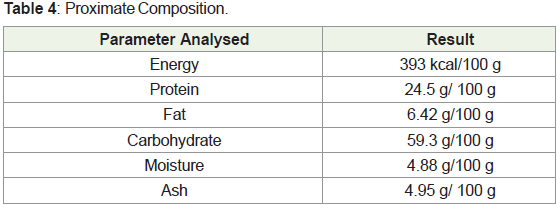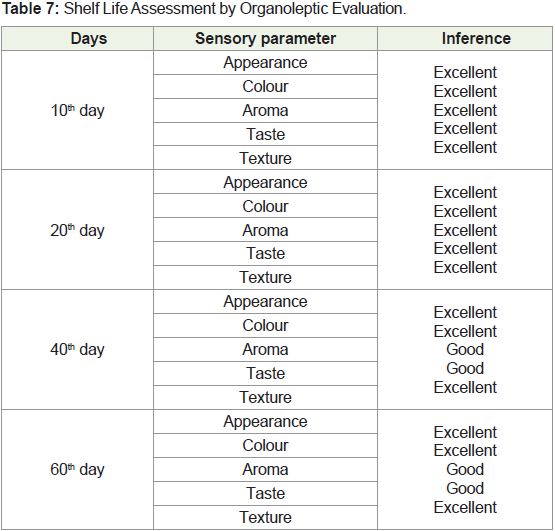Research Article
Preparation of Ready-To-Serve Chutney Powder using Various Dried Microgreens, Its Organoleptic, Experimental and Shelf Life Analysis
Leah Anna Abraham* and Kavitha Vijayan
Dietetics and Food Service Management, Department of Family and Community Science, CMS College Kottayam (Autonomous)
686001, Mahatma Gandhi University, Kottayam, Kerala
*Corresponding author: Abraham LA, Dietetics and Food Service Management, Department of Family and Community Science,
CMS College Kottayam (Autonomous) 686001, Mahatma Gandhi University, Kottayam, Kerala; E-mail: leahabraham1928@gmail.
com
Article Information: Submission: 19/09/2022; Accepted: 21/10/2022; Published: 28/10/2022
Copyright: © 2022 Leah Anna Abraham, et al. This is an open access article distributed under the Creative Commons Attribution
License, which permits unrestricted use, distribution, and reproduction in any medium, provided the original work is properly cited.
Abstract
Formulation of new product involves modification of an existing product or formulation of entirely new product. This present study is focused on formulation
of Ready- To-Serve microgreen chutney powder with an intention of preserving microgreens for longer duration and to get increased shelf-life. For this, various
microgreens were grown and RTS microgreen chutney powder was developed and chosen based on organoleptic evaluation and highest yield microgreens.
For the preparation of RTS microgreen chutney powder, microgreens were dried in a low temperature of 50⁰C for 3-4 hours and powdered. After organoleptic
evaluation, green gram RTS microgreen chutney powder was rated the best with overall acceptability mean score of 4.36. The antioxidant level has been
retained at 3664 mg/100 g and is rich in calcium which is 350 mg/100 g.
Keywords
Analysis; Chutney powder; Formulation; Microgreens; Organoleptic; Shelf life
Introduction
“The creation of products with new and different characteristics
which provides new and extra benefits to customers termed as Product
Development. The life cycle of Product Development consists of Idea
Generation, Idea Screening, Concept Development, Concept Testing
and Business Analysis [1].
The departments of manufacturing, engineering, research &
development, marketing, finance and purchasing should coordinate
to make the “New Development Product” effective [2].
A new product can be created from already existing chutney
powder by adding microgreens to enhance its nutritional value
and characteristics. The chutney powder is a staple food commonly
consumed among the Indians as a ready to eat food without
refrigerated storage for maximum up to twelve days. Literature review
reveals that various food ingredients are used in the development of chutney powder based on their seasonal availability of those products
[3].
Rohini N, Sathiyamurthy VA, Arumugam T (2016), has defined
“Microgreens as a tiny vegetable green that is used both as a visual and
flavour component or ingredient primarily in fine dining restaurants
[4].
“Microgreens” is a marketing term used to describe young and
tender edible seedlings harvested when the cotyledonary leaves have
fully developed and the first true leaves emerge [5].
Microgreens are new emerging food products having two fully
developed cotyledons with the first pair of true leaves emerging
or partially expanded and is used to enhance salads or as edible
garnishes and its consumption has been increased due to the presence
of bioactive components such as vitamins, minerals and antioxidants
in higher amounts.
They typically have a short shelf life due to rapid product deterioration. Microgreens are usually 1-3 inches in height, harvested
at 7-14 days after germination, depending on the species, and sold
with the stem and attached cotyledons (seed leaves). They provide a
large array of intense flavours, vivid colours and tender textures [6].
Commonly found microgreens are amaranth, beet, lettuce,
radish, mustard, sunflower and peas. Regarding the cultivating
conditions, microgreens are a versatile product. They may be grown
in greenhouse or indoor, with natural or artificial light sources
and in soil or in soilless systems. One way to preserve such plant
products is to dry them in order to preserve their desirable qualities,
reduce storage volume and to extend shelf-life. In addition, it is
also important to retain the biological activity of important phyto
constituents, including antioxidants and nutrients as well as avoid
undesirable chemical or physical changes like browning and loss of
colour [6].
Growing microgreens is relatively a simple process, even if
microgreens life cycle is very short and hence certain measures are
applied for improving seeds germination. They are done to determine
a more rapid stabilization and to promote vigorous seedlings.
Also, it is done to shorten the greenhouse production and thus the
production cost [7].
Based on the above mentioned facts, the present study was done
to assess the yield of various microgreens by cultivating them and to
find out the best harvesting period from the 10 microgreens grown
(Figure 1). To develop RTS microgreens chutney powders from
different type of microgreens and to find out the best among them
based on organoleptic evaluation and highest yield microgreens. To
compare the organoleptic quality of newly developed microgreens
chutney powder with a standard breakfast chutney powder. To
analyse nutritional components present in RTS microgreens chutney
powder by various experimental analysis, to assess the shelf life by
microbial analysis and organoleptic evaluation (Figure 2).
Materials & Methods
Cultivating Various Microgreens to Assess the Yield and Growing Period:
As a trial, more than 10 variants of microgreens were sown and
cultivated. Seeds such as chia seeds, cumin seeds, mustard seeds,
wheat, fenugreek, garden cress, flaxseed, red cowpeas, green gram
and horse gram were chosen randomly and purchased from the local
market. Different mediums such as soil, coirpits and tissue papers
were tried out to find out the best means of cultivation.Selecting the Best Five Variants Based on its Yield:
Based on yield and growing period, 5 variants were selected,
since it has shown better yield with short period of time. Fenugreek,
flaxseed, green gram, horsegram and mustard seeds were chosen to
prepare the RTS microgreen chutney powder.Preparation of Various RTS Chutney Powder Using Dried Microgreens:
After harvesting, the microgreens were dried in a hot air oven at
50⁰C for 3-4 hours and powdered. Ready-to-serve chutney powders
were formulated using the selected microgreens.Selecting the Best among the Developed Microgreen Chutney
Powders and its Comparison with Standard Breakfast Chutney
Powder by Organoleptic Evaluation.
Five varieties of microgreen RTS chutney powder have undergone
sensory evaluation. The best variant was selected on the basis of
sensory score and high yielding variant. A comparison was also done
with a control sample chutney powder and among other developed
chutneys. The control sample chutney powder was developed by self,
similar to breakfast chutney powder available in market.
A) Organoleptic Evaluation:
Sensory evaluation was done by comparing with the control
sample chutney powder and among other chutney powders. A
composite score card was developed and was assessed based on
sensory attributes.Experimental Analysis: Experimental analysis such as proximate
composition and nutrient analysis were determined for developed RTS microgreen chutney powder and dried microgreens respectively. Total
anti-oxidant activity was also done for microgreen chutney powder.
The estimation of nutritional component of dried microgreens was
done for iron and calcium components. The proximate composition
of developed RTS microgreen chutney powder were analysed and the
estimated components were energy, moisture, fat, ash, carbohydrate
and protein. Anti-oxidants are the major bioactive compounds
present in the microgreens. So to determine it, anti-oxidant assay
has been conducted using the method IFL C/QSP G/078 for the
developed RTS microgreen chutney powder.
Shelf Life Evaluation of Developed Microgreens Chutney Powder:
A shelf life study was conducted among the developed microgreen
chutney powder. The evaluation was done by placing 4 jars in room
temperature and 2 packs in refrigerators. The jars were autoclaved and
hygienically packed with headspace. Equal quantity of microgreen
chutney powder was put into the jars and zip lock covers and labelled
individually. Shelf life evaluation was done for 60 days. Each one of
the jars was taken after every 10 days for organoleptic evaluation to
assess the quality of the product.a) Shelf Life Assessment by Microbial Analysis:
Shelf life assessment by microbial analysis of RTS microgreen
chutney powder done were total plate count, yeast and mold analysis
of the product were assessed on 45th day due to COVID pandemic
situation.b) Shelf Life Assessment by Organoleptic Evaluation:
Shelf life assesment by organoleptic evaluation was done by self
due to COVID pandemic situation on day 10, day 20, day 40 and day
60. Attributes such as appearance, colour, aroma, taste and texture
was assessed and rated as excellent, good, fair, poor, very poor.Data Analysis and Interpretation: The data analysed and its
interpretation is given under results and discussions.
Results
Determination of Growing period and harvesting yield of various
microgreens (Table 1).
Organoleptic Evaluation Score of Various Microgreen Chutney
Powder (Table 2).
Experimental Analysis:
Nutrient Analysis of Dried Microgreens (Table 3).Proximate Composition of RTS Microgreen Chutney Powder
(Table 4).
Antioxidant Activity of RTS Microgreen Chutney Powder (Table 5).
Shelf Life Evaluation of Developed Microgreens Chutney
Powder (Table 6).
Shelf Life Assessment by Organoleptic Evaluation (Table 7).
Discussion
Determination of Growing period and harvesting yield of various microgreens:
10 seeds, each of 100g were sown and observed to assess the
growing period and harvesting yield of microgreens. It is also noted
that green gram and horsegram had maximum harvesting yield i.e.,
180g and 200g respectively and growing periods was 7 to 14 days for
green gram and 7 to 10 days for horsegram. Fenugreek seeds took
around 5-10 days and wheat grains took 5 to 15 days for growing
and yield of microgreens obtained was only about 50g. Flaxseed took
6 to 8 days for growing and yielded 60 g of microgreens. Growing
period of garden cress seeds and red cowpeas were similar i.e., 10 to
15 days and 10 to 14 days respectively which yielded 90 g of garden
cress microgreens and 110g red cowpeas microgreens. Chia seeds and
cumin seeds didn’t grow at all.Organoleptic Evaluation Score of Various Microgreen Chutney Powder:
A) Mean Score of Green Gram Microgreen Chutney PowderThe mean score for appearance is 4.4, for colour 4.34, for texture
4.12, for flavor 4.32 and taste 4.32 and the overall acceptability of the
sample is 4.36.
B) Mean Score of Horse Gram Microgreen Chutney Powder:
The mean score for appearance is 4.26, for colour 4.36, for texture
3.94, for flavor 3.72, for taste 3.8 and the overall acceptability of the
sample is 3.9.C) Mean Score of Mustard Microgreen Chutney Powder:
The mean score for appearance is 4.16, for colour 4.22, for texture
3.8, for flavor 3.34, for taste 3.3 and the overall acceptability of the
sample is 3.34.D) Mean Score of Fenugreek Microgreen Chutney Powder:
The mean score for appearance is 3.8, for colour 3.92, for texture
3.32, for flavor 3.06, for taste 3.14 and the overall acceptability of the
sample is 3.3.D) Mean Score of Flaxseed Microgreen Chutney Powder:
The mean score for appearance is 3.92, for colour 4.02, for texture
3.38, for flavor 2.52, for taste 2.48 and the overall acceptability of the
sample is 2.8.E) Overall Acceptability Mean Score of Microgreens Chutney Powder:
The overall acceptability score of green gram is 4.36, horse gram is
3.9, mustard seeds is 3.34, fenugreek is 3.3 and that of flaxseed is 2.8.According to Nivedha (2018), the mean score of appearance is
7.9±0.22, for colour 7.8±0.22, for flavor 8.6±0.54 and taste 8.6±0.54
and overall acceptability of amaranth microgreen chutney powder is
8.2±0.44.
According to Nivedha (2018), the mean score of flavor 8.1±0.84
and taste 7.8±0.83 of beet microgreen chutney powder is 8.2±0.44.
Experimental Analysis:
The nutrient analysis of dried microgreens contains 350 mg Ca in
100 g and 7.18 mg of iron per kilogram.While considering a normal breakfast chutney powder, Ca
content is very low. But in this microgreen chutney powder Ca
content is much higher i.e. 350 mg/100 g.
According to Fuente (2019), among 30 varieties of rassicacea
microgreens grown in peat moss substrate evaluated by Xiao et al.
calcium content was found to be in range of 41 to 88 mg/100g FW
and iron was found between 0.47 to 0.72 mg/100 g FW. Also level of
Ca and Fe in broccoli microgreens was found to be 59-202 mg/100 g
FW and 0.59-1.2 mg/100 g. According to Xiao (2016), Brassiacaceae
microgreens contained 28 to 66 mg/ 100 g FW of calcium and 0.47 to
0.84 mg/ 100 g FW of iron [8].
According to Nivedha (2018), iron content of mustard leaves and
sunflower leaves microgreen chutney powder ranges between 5.53mg
and 16.48mg respectively. Calcium content of mix of amaranth, beet
and lettuce microgreen chutney powder ranged from 15.66 mg [6].
Proximate Composition of RTS Microgreen Chutney Powder:
The proximate composition present in RTS microgreen chutney
powder. Energy was found to be 393 kcal/100 g, protein content was
24.5 g/ 100g, fat content 6.42 g/100 g, carbohydrate content 59.3
g/100 g, moisture content 4.88 g/ 100g and ash content was found to
be 4.95 g/ 100g.According to Nivedha (2018), moisture content in beet leaves
microgreen chutney powder was found to be 6.17 g and in mustard
leaves microgreen chutney powder was 14.53g. Protein content of
mustard leaves microgreen chutney powder was 20.59 g and 44.23 g in beet leaves microgreen chutney powder. Ash content of radish
leaves microgreen chutney powder was 4.65 g and mustard leaves
contained 6.63 g.
Antioxidant Activity of RTS Microgreen Chutney Powder:
The total antioxidant activity of RTS microgreen chutney powder
was found to be 3664 mg/100 g. The recommended daily intake of
antioxidants is a minimum of 400 g/day of fruits and vegetables, but
the developed microgreen contains 3664 mg/100 g.According to Fuente (2019), amount of Vitamin C in fresh
microgreens were found as 31-56 mg/100 g FW, which would provide
between 38 and 70% of recommended daily intake for vitamin C.
According to Polash (2018), the experiment revealed that after
1st day of harvest the microgreens of four tested varieties (mustard,
leaf mustard, radish and cabbage) showed vitamin C (16.23, 13.17,
8.57 and 8.03mg/100g, respectively) and the activity of DPPH (0.75,
1.20, 2.90 and 3.57μg/ml respectively) whereas these substances
deteriorated significantly on 3rd or 5th day of harvest.
Shelf Life Evaluation of Developed Microgreens Chutney Powder:
Shelf Life Assessment by Microbial Analysis
The results of shelf life assessment done for RTS microgreen
chutney powder by microbial analysis on 45th day. Total plate count
was found to be CFU/g and yeast and mold was found to be CFU/g. It
indicates that the results obtained are little higher value than normal
range but is still acceptable to consume since it was acceptable with its
appearance, color, aroma, taste and texture on 60th day.Shelf Life Assessment by Organoleptic Evaluation
The result of shelf life assesment by organoleptic evaluation on
day 10, day 20, day 40 and day 60. Attributes such as appearance,
colour and texture was excellent till day 60th. Aroma and taste of the
product was rated as good on 40th and 60th day and on all other days
it was rated as excellent.
Conclusion
On the basis of findings, it can be concluded that microgreens
can be grown easily at home and can be included in the diet as it has
many nutritional benefits. The microgreens can be harvested within
5-14 days after sown. RTS microgreen chutney powder was developed
with an intention of preserving microgreens for longer duration and
to prove increased shelf- life. It was also developed considering a
variety from breakfast chutney powders available in the market. For
the preparation of RTS microgreen chutney powder, microgreens
were dried in a low temperature of 50⁰C for 3-4 hours and powdered.
The antioxidant level has been retained at 3664 mg/100g and is rich
in calcium which is 350 mg/100g. Organoleptic evaluation was also
conducted for developed microgreen chutney powder and it was
found to be acceptable.
Acknowledgement
I acknowledge the special divine providence, which was experienced during the period of study. First and foremost the
investigator thanks God Almighty for the successful completion of
the research work.
I extend whole hearted gratitude to Dr.Varghese C. Joshua,
Principal, CMS College Kottayam (Autonomous) for the valuable cooperation
extended during this study.
I am deeply indebted to Dr. Miriam Mani, Head of the
Department, Family and Community Science, for her valuable help,
necessary directions and encouragement during the period of study.
I would like to express my heartfelt gratitude to Mrs. Kavitha
Vijayan, the guide of the study, for giving me insight in to all the
aspects of my study, constant encouragement, expert guidance,
valuable corrections and constant support since the planning till the
completion of the project.
I am also thankful to Dr. Jinu John, Faculty, Department of
Biotechnology (Self-financing) for his cooperation and constant
support throughout the study.
I also extend my whole hearted thanks to all the Assistant
Professors and classmates who helped me to complete the project
successfully.
Finally, I place and record my sincere thanks to my parents and
siblings who contributed their time and suggestions in the successful
completion of the research work.

